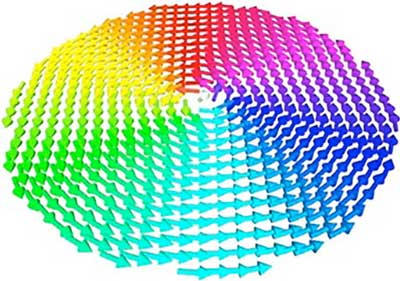| Feb 06, 2020 | |
Novel magnetic nanostructures for emerging biomedical applications |
|
| (Nanowerk Spotlight) Small magnetic objects, which have been used successfully in technological applications such as data storage, also show promise in the biomedical field. | |
| New types of magnetic nanostructures have interesting properties that enhance novel medical applications in diagnosis and allow the exploration of new therapeutic techniques. | |
| In Applied Physics Review ("Magnetic nanostructures for emerging biomedical applications"), researchers review the state of the art in this field. | |
| One especially interesting advance involves exotic spin configurations, like a vortex state in nanodiscs, where magnetic moments arrange into a curly geometry. | |
 |
|
| Vortex core schematic. (© Applied Physics Reviews) | |
| Isolating and separating particular cells from a blood or tissue sample is crucial for a variety of medical applications, such as gene therapy or in cancer diagnosis and treatment. Standard procedures involve filtration and centrifugation, but cells of similar sizes or densities cannot be separated this way. | |
| One approach to this problem has been to coat spherical iron oxide beads with antibodies that specifically bind the cells of interest. Then, the desired cells are separated through the application of magnetic fields | |
| However, this can require high magnetic field strengths, so a second approach using nanowires, has been tried. | |
| A third way involves nanodiscs, either in a vortex state or a synthetic antiferromagnetic configuration (SAF), consisting of two ferromagnetic layers separated by one non-magnetic layer. The surface of the nanostructures can be treated with fluorescent probes, allowing the investigators to observe motion of the particles in response to an applied field. | |
| Another biomedical application that can benefit from magnetic nanostructures is MRI. Because the basic technique has low sensitivity, contrast agents are usually needed. The most widely used agents are gadolinium complexes, but these have raised toxicity concerns. | |
| Both nanodiscs and nanowires coated with biocompatible substances have properties that would make them good as MRI contrast agents. | |
| An innovative application area of magnetic nanostructures involves targeted cell annihilation for cancer treatment. Nanodiscs created in a spin vortex state or synthetic antiferromagnetic structures show great promise. | |
| High tumor-cell death rates, up to 90%, were observed when relatively weak magnetic fields were applied to in-vitro assays. The mechanism that leads to cell death is the mechanical force that results when a rotating magnetic field spins the nanodiscs, destroying tumor cells from the inside. | |
| To date, most of the studies reviewed have been carried out in the lab, so issues such as retention or excretion by internal organs, or transport through capillaries are still an issue. Further study is required to address these real-world effects. | |
| This work was developed within the scope of the ongoing European project MSCA-RISE-734801-MAGNAMED: Novel magnetic nanostructures for medical applications, which involves 12 European and American Academic Institutions and 2 Industry partners. | |
|
Source: Provided by Institute of Physics for Advanced Materials, Nanotechnology and Photonics (IFIMUP), University of Porto as a Nanowerk exclusive
|
|
|
Become a Spotlight guest author! Join our large and growing group of guest contributors. Have you just published a scientific paper or have other exciting developments to share with the nanotechnology community? Here is how to publish on nanowerk.com. |
|
